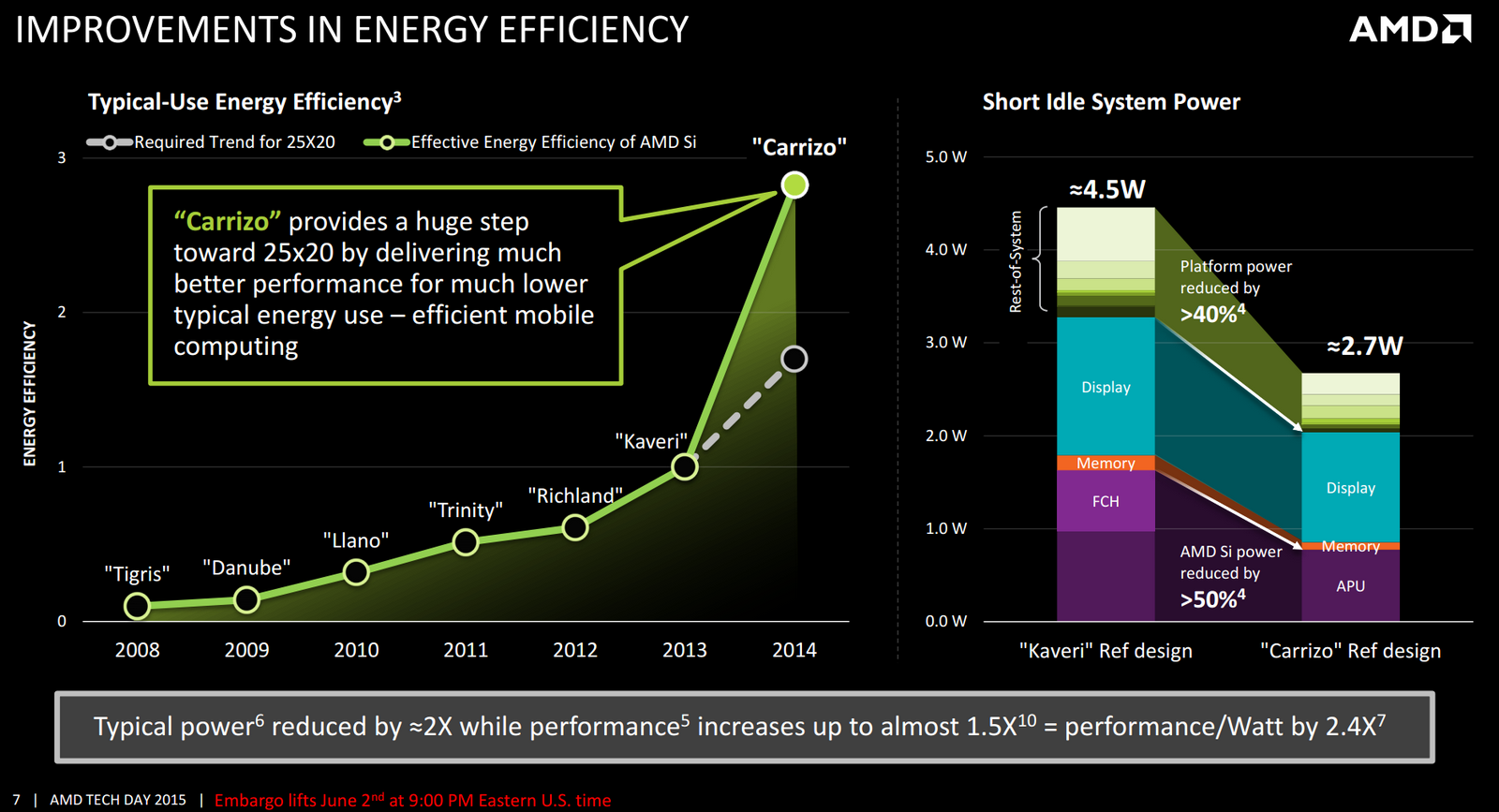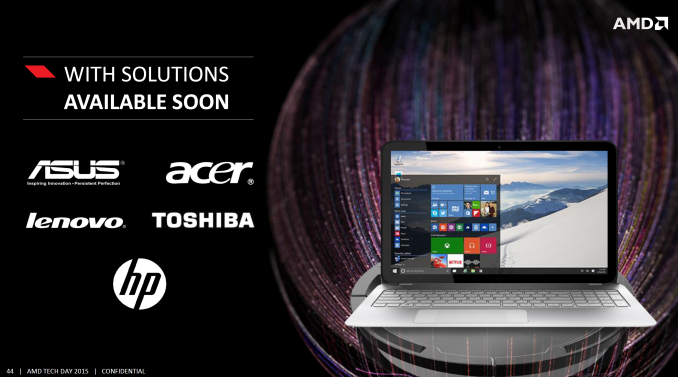Who Controls the User Experience? AMD’s Carrizo Thoroughly Tested
by Ian Cutress on February 4, 2016 8:00 AM ESTHow to Iterate Through Design
While AMD’s Carrizo is still based on this Bulldozer design, it represents the fourth iterative update, called Excavator, which is now produced at the 28nm process node compared to the 32nm original design. At each juncture from Bulldozer (rev1) through Piledriver (rev2) and Steamroller (rev3) to Excavator (rev4), AMDs goal has been the same as most other semiconductor manufacturers - produce a list of fixes that provide the most benefit for the least amount of time, then work through that list. This is not an uncommon procedure for iterative updates, and in itself retains the logical thought of improving the design as much as possible.
What this method perhaps misses are the bigger leaps in design philosophy where shifting fundamental paradigms can have a bigger impact on key properties of the product, but these changes in philosophy often carry the burden of increased risk and cost, where failure is seen as a waste of resources. Nevertheless, the Excavator core and the Carrizo design, according to AMD, implements a significant number of fundamental paradigm shifts compared to previous revisions, and as a result Carrizo behaves differently in a large number of key metrics. The base design underneath is still inherently the Bulldozer concept, however the 'skunkworks' style adjustments, according to AMD, significantly improve the power consumption, the single core performance and the potential battery life over previous AMD processor designs in mobile segments. All current gains on this design have only come from AMD, lacking independent verification.
For a more detailed look at AMD's Excavator design, with high density libraries and power management, read our run down of Carrizo's technology from our launch article here.
Gaining OEM Support
Aside from the processor itself, the image of AMD based devices, especially in the mobile segment, is not overly positive. As mentioned above, there are two sides to this story - original equipment manufacturers whom use AMD processors in their designs have to be confident that it will provide a level of performance suitable for the experience they expect the consumer to have. Similarly, the end user must also receive a platform that benefits the price point purchased and retains a level of quality consistent with providing a good experience. Former poor experiences can be a heavily influence in future purchasing decisions, and those with a negative opinion require a fundamental design change or significant external recommendations in order to make a change against a gut feeling. If a user keeps getting a poor design, regardless of which side of the fence is responsible (or both), both will be negatively affected, and sometimes one more than the other.
This applies to both consumers and business users, the latter of which is often down to individuals at companies making recommendations based on brand and business sense. If a business buyer insists on Dell, for example due to a long term support contract, they will source the most appropriate Dell device out of the range based on research and that gut feeling. In order for a semiconductor company to be competitive in this space, they need to work closely and extensively with the business OEMs to build devices that facilitate the experiences required with a level of industrial design that enables the appropriate experience. It is not difficult to search online for details of users that are disgruntled with devices from both Intel and AMD, particularly in areas such as industrial design of the device, performance, battery life, temperature and quality.
While Intel has a number of arms with partners based on the success of the Core architcture over the last decade, AMD’s stable of partners is not so large. AMD has three top tier partners – HP, Lenovo and Toshiba – all of whom are represented in this report. Like many other notebook manufacturers in the industry, all of these three are well known for some models but hounded on others, especially those at the bottom of the price stack or due to unique sets of security principles. As mentioned previously, HP focuses a lot on the Enterprise space with items like the Elitebook line, but if personal experience is anything to go by, consumer use of Elitebooks has declined. Toshiba meanwhile suffers from the race-to-the-bottom syndrome where sometimes a simple $30 upgrade can make the difference, and Lenovo’s recent software issues have been well documented. AMD works with these three partners the most, such that when they score a big contract (such as 30,000 units with HP for Dr. Pepper/Snapple) it is actually a big contract for AMD.












175 Comments
View All Comments
karakarga - Friday, February 5, 2016 - link
Including all, AMD and nVidia both at their funeral state! They can not possibly open 22, 14, 10 etc. micron fabric.Intel spended 5 billion dollars to open their new Arizona factory, they will pass lower processes there as well. AMD and nVidia can not get, even a billion dollar profit in these years. It is impossible for them to spend that much money to a new low process factory.
Those little tweaks can not help them to survive....
testbug00 - Friday, February 5, 2016 - link
They don't build factories. TSMC and Samsung (and GloFo to a lesser extent) build factories and do R&D for these processes. Nvidia, AMD. Samsung, Qualcomm, MediaTek and many other companies design chips to the standards of TSMC/Samsung/GloFo and pay money for wafers and running the wafers through the fab.The cost for this per wafer is meant to get all that money back in a few years. And than the process keeps on running for over 10 years sometimes.
It is getting more expensive to get to smaller nodes and the performance increase and power decrease is getting smaller. And costs more to design chips and run wafers. So it is getting harder to find the funds to shrink. Which is one of the reasons Intel has delayed their 10nm process.
yannigr2 - Friday, February 5, 2016 - link
Thanks for this review. Really needed for sometime. It was missing from the internet, not just Anandtech.As for the laptops, they say as much as there is to tell. Small Chinese makers, who no one knows they exist, would built better laptops than these. HP, Toshiba and Lenovo in this case, multibillion international giants that seems have all the technicians and the R&D funds necessary, end up producing Laptops with "strange" limitations, bad choices, low quality parts and in the end put prices that, even with all those bad choices and limitations, are NOT lower than those on Intel alternatives. It's almost as if Intel makes the choices for the parts in those laptops. Maybe their is a "trololol" sticker on them somewhere hidden addressed to AMD. I guess that way those big OEM don't make Intel too angry and at the same time, if there is another legal battle between AMD and Intel in the future, they will have enough excuses to show to the judge in their defense, if accused that they supported a monopoly.
ToTTenTranz - Friday, February 5, 2016 - link
This article is what makes Anandtech great. Just keep being like this guys, your work is awesome!I'm going to spend some time clicking your ads, you deserve it :)
As for the "poll" about who's to blame, IMHO it is:
1 - AMD for letting OEMs place Carrizo in designs with terrible panels and single-channel solutions. It's just not good for the brand. "You can't put a Carrizo with single-channel cheap RAM because that's not how it was designed. You want to build bottom-of-the-barrel laptop? We have Carrizo-L for you."
I'm pretty sure Intel has this conversation regarding Core M and Atom/Pentium/Celeron solutions. I know AMD is in a worse solution to negotiate, but downplaying Carrizo like this isn't good for anyone but Intel.
In the end, what AMD needs is a guy who can properly sell their product. Someone who convince the OEMs that good SoCs need to be paired with decent everything-else.
$500 is plenty for a 12/13" IPS/VA screen (even if it's 720/800p), 128GB SSD and 4+4GB DDR3L. Why not pull a Microsoft's Surface and build a decent SKU for that price range so that other OEMs can follow? Contract one OEM to make the device they envisioned, sell it and see all others following suit.
2 - OEMs for apparently not having this ONE guy who calls the shots and knows that selling a crappy system automatically means losing customers. And this ONE other guy (or the same) for not knowing that constantly favoring Intel with their solutions is bound to make the whole company's life miserable if Intel's only competitor kicks the bucket. The consumer isn't meant to know these things, but the OEMs certainly are.
It's 2016. We're way past the age of tricking the customer to buy a terrible user experience through big numbers (like "1TB drive woot"). He/She will feel like the money just wasn't and next time will buy a mac.
Want a $300-400 price point? Get a Carrizo-L with a 128GB SSD and a 720p IPS panel. Want $500-700 Price point? Get a Carrizo with dual-channel, 256GB SSD and 900p/1080p IPS screen.
joex4444 - Friday, February 5, 2016 - link
Anything under 1080p is simply not usable. All these 1366x768 panels are just awful. I have an old netbook with one (12.1") and I've put a small SSD in there and loaded it with Ubuntu. I cannot have a Google Hangouts window open and a web browser open wide enough to view most pages. Basic web browsing + IM - 1366x768 completely fails at the task.testbug00 - Friday, February 5, 2016 - link
768p panels are fine if they are good quality, in 11" laptops.900p good up to 13", and 1080p minimum for 14+.
Honestly I wish we stayed with 8:5 14x9, 16x10, 19x12z
jabber - Saturday, February 6, 2016 - link
Indeed, 768p is fine on my 11" Samsung Chromebook but I would not tolerate it on anything bigger. IMO 1600x900 should be the minimum screen res for budget machines. 1080p for midrange and whatever you like for higher end.jjpcat@hotmail.com - Monday, February 8, 2016 - link
Resolution is not as important as the quality of the panel. I used a Lenovo X1 Carbon. It has a 14" 1080p screen. But it's a TN panel and that just makes it a pain in the ass. I am amazed that Lenovo uses such a lousy panel in its $1k+ laptop while some 10" sub-$200 tablets use IPS.testbug00 - Friday, February 5, 2016 - link
Toshiba can make a $400 chromebook with a good 1080p display. Fully agreed.1080p panel, make it thicker so you can put a larger battery and so the laptop can handle up to 35W from the APU. Do dual channel.
When plugged change APU power mad to 35W, when in battery make it 15W. Probably can be done for $500 for a 15" laptop with an A8. $50/100 upgrade to 128/256GB SSD and $50/100 upgrade to A10/FX.
Dobson123 - Friday, February 5, 2016 - link
"The APU contains integrated ‘R6’ level graphics based on GCN 1.0, for 384 streaming processors at a frequency of 533 MHz."Isn't it GCN 1.1?